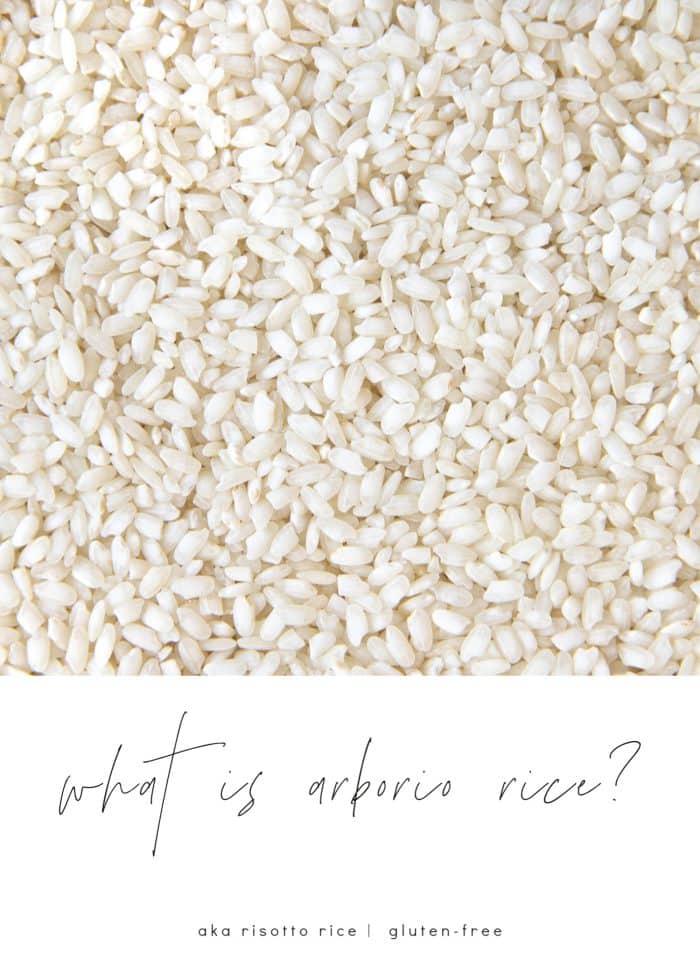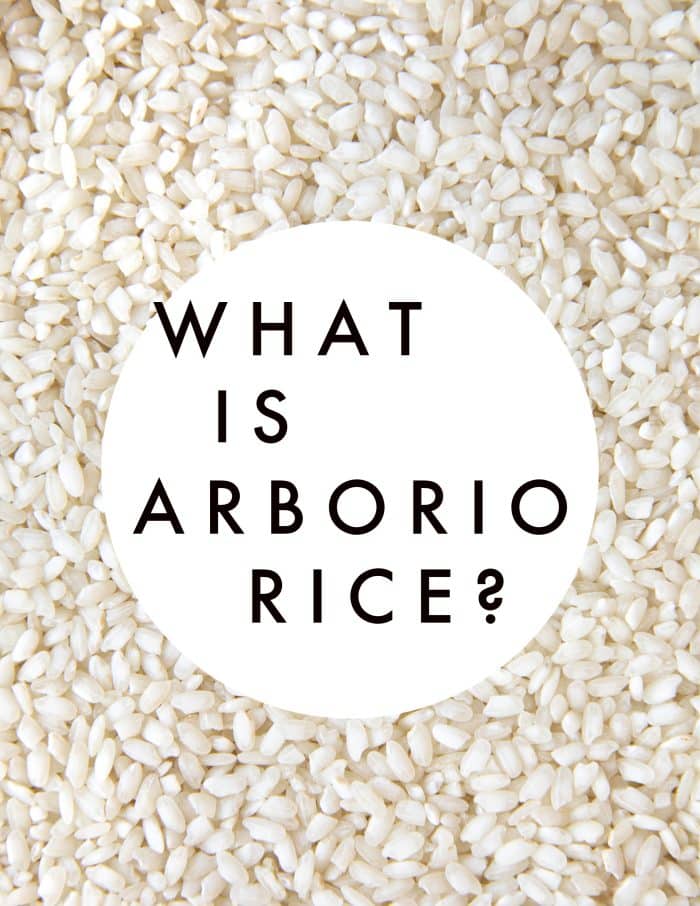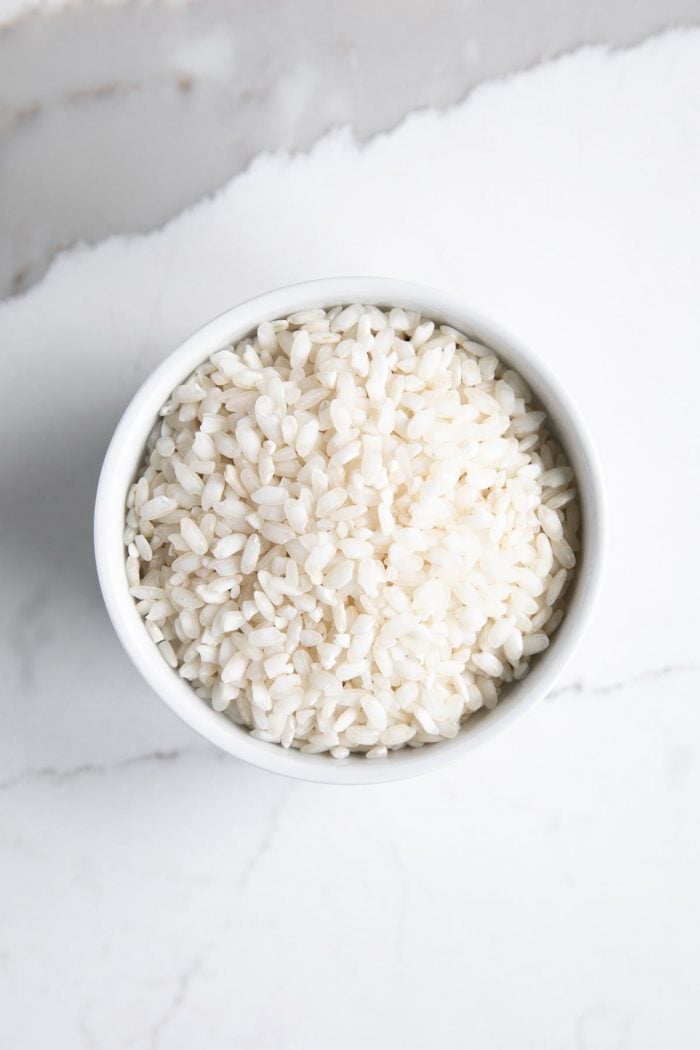This post may contain affiliate links. See my disclosure policy.
Everything you’ve ever wanted to know about Arborio Rice: what it is, nutrition, uses, and how to cook it (3 ways!)

What is Arborio Rice?
Arborio rice is best-known as the rice used to make risotto. A type of short-grain rice to medium-grain rice, it is named after an area in Italy where it was originally cultivated – the town of Arborio in the Po Valley.
Now, arborio rice is also grown in states throughout the United States including Arkansas, California, Texas, and Missouri.
Characteristically short, plump, and oval-shaped, arborio is a variety of superfino rice and one of the largest of all short-grain Italian rice varieties belonging to the species Oryza sativa japonica.
Arborio rice is high in the starch, amylopectin. Upon cooking, this rice releases its natural starch, resulting in creamier, more luscious rice that is firmer and chewier when compared to regular rice such as long-grain basmati rice or jasmine rice.
Of course, like all types of rice, arborio rice is 100% gluten-free.
How to Cook Arborio Rice
There are three popular methods for preparing arborio rice: stovetop, Instant Pot (pressure cooker), and microwave.
Depending on the recipe, the Instant Pot is my favorite way to prepare this rice, but there is something quite hypnotic about watching plump little grains of rice transform into the ultimate bowl of cooked rice.
How to cook arborio rice on the stovetop:
1. Add the homemade chicken stock (or vegetable broth/water) to a medium saucepan. Bring to a simmer, reduce heat to low, cover, and set aside to keep warm.
- The rice to water ratio is 1:4 or for every 1 cup rice, you’ll need approximately 4 cups of water.
2. Melt the butter in a large saucepan over medium heat. Add the onions and sauté for 5-7 minutes, or until the onions are soft and translucent.
- Feel free to skip the onion or add additional vegetables like mushrooms.
3. Add the rice and salt and mix thoroughly to combine with the onions and butter. Cook for 1-2 minutes, or just long enough to allow the rice to turn fragrant. Careful not to brown the rice.
- Sometimes I like to add dry white wine to the rice after it’s been toasted for 1-2 minutes. All you’ll need is about 1/2 cup per cup of rice. Allow the rice the absorb the wine before moving to the next step.
4. Add a ladle (approximately 1/2 cup) of hot chicken stock to the rice. Stir until the liquid is fully absorbed. When nearly all the liquid is absorbed, stir in an additional ladle of hot chicken broth.
5. Continue adding chicken stock, one ladle at a time. Stir between each addition and wait to add the next ladle until the stock has been absorbed. This process will take anywhere between 20-30 minutes. Continue until the grains are al dente, or tender, yet firm.
(scroll down to the recipe card below to find Instant Pot and microwave instructions)
What Can I Add to Cooked Arborio Rice?
- Additional butter
- Parmesan cheese
- Fresh herbs
- Sauteed vegetables
- Fresh lemon juice
- Cooked chicken or shrimp
What Can You Substitute for Arborio Rice?
If you’re looking to make risotto, but can’t get your hands on any arborio rice, try these other rice or grain varieties:
- Carnaroli – Perhaps more difficult to find than arborio rice, this “king of rice” is another type of Italian superfino rice high in amylopectin.
- Vialone Nano – This fino or semifino Italian variety of rice may be smaller in size but it is capable of absorbing a lot of liquid. So much that it is known to triple in size.
- Sushi rice (Japanese rice or sticky rice) – The grains are short, plump, and contain more moisture when cooked, making them stickier than other rice varieties.
- Farro, pearled barley, steel-cut oats – for added nutrition.
Nutrition
A 3.5-ounce (100-gram) serving of dry arborio rice provides (source):
- Calories: 340
- Carbohydrates: 75 grams
- Protein: 7.55 grams
- Fiber: 4 grams
- Fat: 1 gram
- Potassium, K: 85 mg
Nearly 90% of the calories in rice comes from carbohydrates. This makes sense, given its high starch content. And while one may expect this creamy rice to be higher in overall carbohydrates and (perhaps) even calories, it contains nearly identical amounts compared to long-grain white rice which has 344 calories and 78 grams of carbs per serving (2). Unlike white rice, however, arborio rice contains 4 grams of fiber whereas white rice contains none (1, 2).
Uses and Recipes
Arborio rice is most well-known for its use in risotto. But what else? Add this creamy rice to rice pudding, arancini (Italian fried rice balls), soups, or even paella.
Of course, risotto (like this one with instant pot butternut squash risotto) is always a fabulous idea.
But what if you’re simply looking to cook arborio rice like regular rice? easy. To start, wash your rice. This will remove any surface starch. Cook it on the stovetop using your favorite method. It won’t absorb as much liquid, will maintain some stickiness, all while maintaining a fabulous al dente texture.
Buying & Storing
Arborio rice is found in the rice section of most major supermarkets, as well as online or Italian specialty food store. Sold in boxes, sacks, bags, canisters, or vacuum-sealed to maintain freshness, arborio rice is often labeled as “risotto rice”, especially in the US.
Uncooked arborio rice, when stored in an airtight container and in a cool dry place, will keep for years. Keep it stored in the pantry, refrigerator, or freezer.
Arborio rice, once cooked, is best enjoyed immediately or within two days (especially in the case of recipes such as risotto). Allow it too cool before transferring to a container with a tight-fitting lid. Place in the refrigerator until ready to enjoy again.
More Rice Recipes,
Creamy Chicken and Wild Rice Soup Recipe
How to Cook Perfect Instant Pot Rice
Do you love arborio rice? Please leave me a comment and let me know! I always love to hear your thoughts.

How to Cook Arborio Rice Recipe
Ingredients
Stovetop
- 8 cup low-sodium chicken stock
- 2 tablespoon butter, or olive oil
- 1 onion, diced
- 2 cups arborio rice
- 1 teaspoon salt
Instant Pot
- 4 cups low-sodium chicken stock
- 2 tablespoon butter, or olive oil
- 1 onion, diced
- 2 cups arborio rice
- 1 teaspoon salt
Microwave
- 2 cups low-sodium chicken broth
- 2 tablespoon butter, or olive oil
- 1 cups arborio rice
- ½ teaspoon salt
Instructions
Stovetop
- Add the chicken stock (or vegetable broth/water) to a medium saucepan and set over medium-high heat. Bring to a simmer, reduce heat to low, cover, and set aside to keep warm.
- Melt the butter in a large, heavy-bottomed saucepan over medium heat. Add the onions and sauté for 5-7 minutes, or until the onions are soft and translucent.
- Add rice and salt and mix thoroughly with the onions. Cook for 1-2 minutes, or just long enough to allow the rice to turn fragrant. Careful not to brown the rice.
- Increase heat to medium to medium-high. Add a ladle (approximately 1/2 cup) of hot chicken stock to the rice. Stir until the liquid is fully absorbed. When nearly all the liquid is absorbed, stir in an additional ladle of hot chicken broth.
- Continue adding chicken stock, one ladle at a time. Stir between each addition and wait to add the next ladle until the stock has been absorbed. This process will take anywhere between 20-30 minutes. Continue until the grains are al dente, or tender, yet firm.
- Season or garnish with additional butter, Parmesan cheese, or fresh herbs.
Instant Pot
- Add the chicken stock (or vegetable broth/water) to a medium saucepan and set over medium-high heat. Bring to a simmer, cover, and remove from heat.
- Set pressure cooker to sauté mode.
- Add the butter and melt. Once melted, add the onion and cook for 3-5 minutes, or until soft and translucent.
- Add the rice and salt and mix thoroughly with the onions. Cook for 1-2 minutes, or just long enough to allow the rice to turn fragrant. Careful not to brown the rice.
- Turn off the sauté function. Stir in the warmed chicken stock. Secure lid and set pressure cooker to MANUAL high pressure for 5 minutes.
- Allow the pressure to release naturally for 5 minutes before switching to quick release.
- Stir in additional butter, Parmesan cheese, or fresh herbs, if desired.
Microwave
- Add the chicken stock to a large microwave-safe dish. Heat until the broth is hot, but not boiling.
- Add the butter, arborio rice, and salt to the broth. Mix thoroughly to combine and cover with a damp paper towel. Cook for 5 minutes. Mix thoroughly, check for doneness, and continue to cook until al dente.
- Season or garnish with additional butter, Parmesan cheese, or fresh herbs.
Notes
- Nutritional information is for stovetop arborio rice.
- Do not rinse your rice if you plan to cook risotto.
- Gluten-free
Nutrition
Nutrition information is automatically calculated, so should only be used as an approximation.

















Can I cook arborial rice in a rice cooker? Can I use chicken stock instead of water?
Yes, you can cook Arborio rice, often used for risotto, in a rice cooker. However, it may not give you the creamy texture that is characteristic of a traditional risotto, which comes from constant stirring while cooking. Regarding your second question, yes, you can replace water with chicken stock when cooking Arborio rice. The chicken stock will infuse the rice with more flavor and is a common substitution in many rice dishes. Always refer to your specific rice cooker’s guidelines as they can differ between models.
worst instructions ever. What goes first? Like really
Please see the recipe card at the bottom of the post, above this comment section for full instructions 3 different ways.
Can I substitute for Arborio rice instead of regular rice in a chicken casserole dish
Unfortunately, no, it wont work well.
Looking at recipe. Is the amount in ounces for the rice in liquid or solid ounces? [ 16 oz to lb ]
Am I correct in assuming that the amount of water is in liquid ounces?
The wonders of the metric system would cure all this confusion. Everything in grams !!!
Thanks, I await your response.
yes, fluid oz 🙂
Really good information about this rice, thankyou for sharing!!
Carolyn NZ